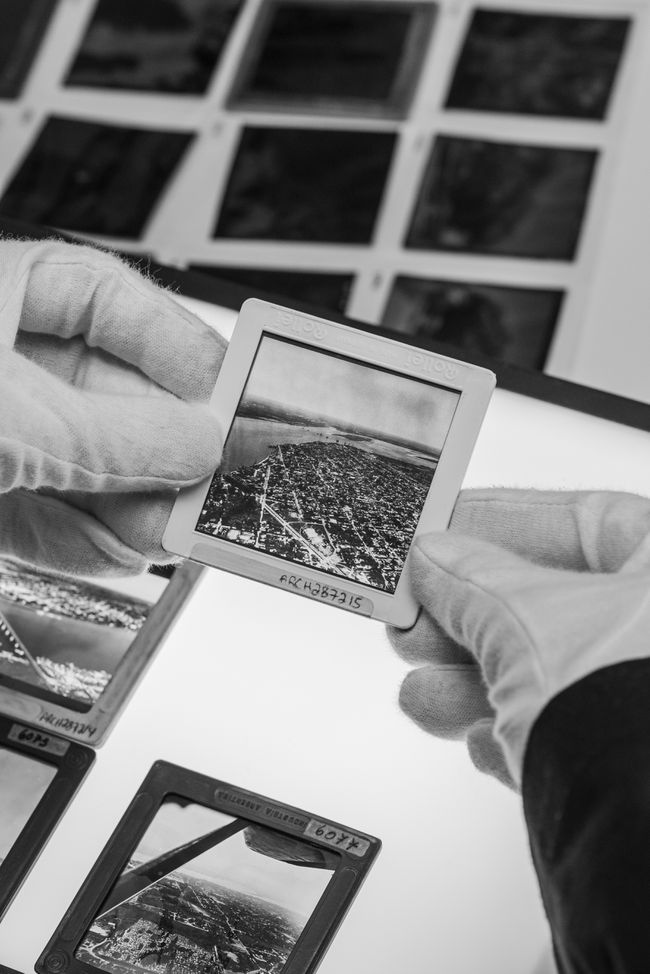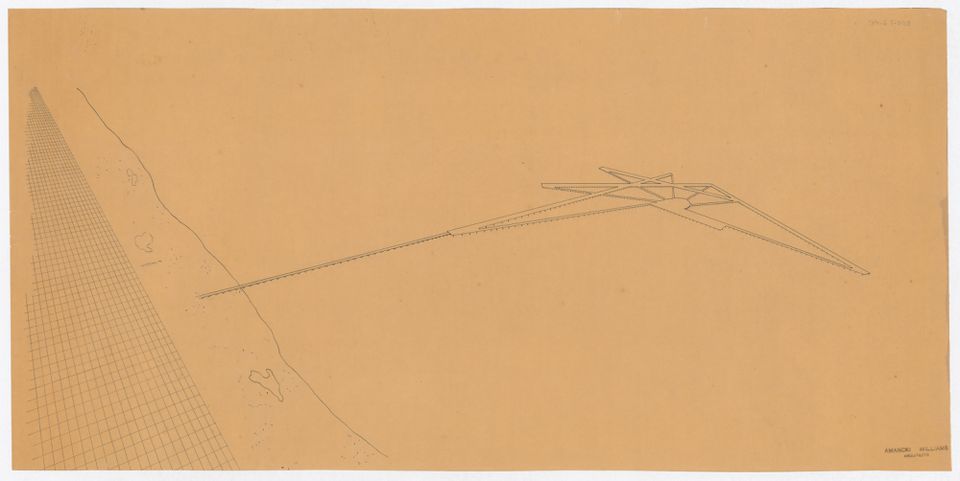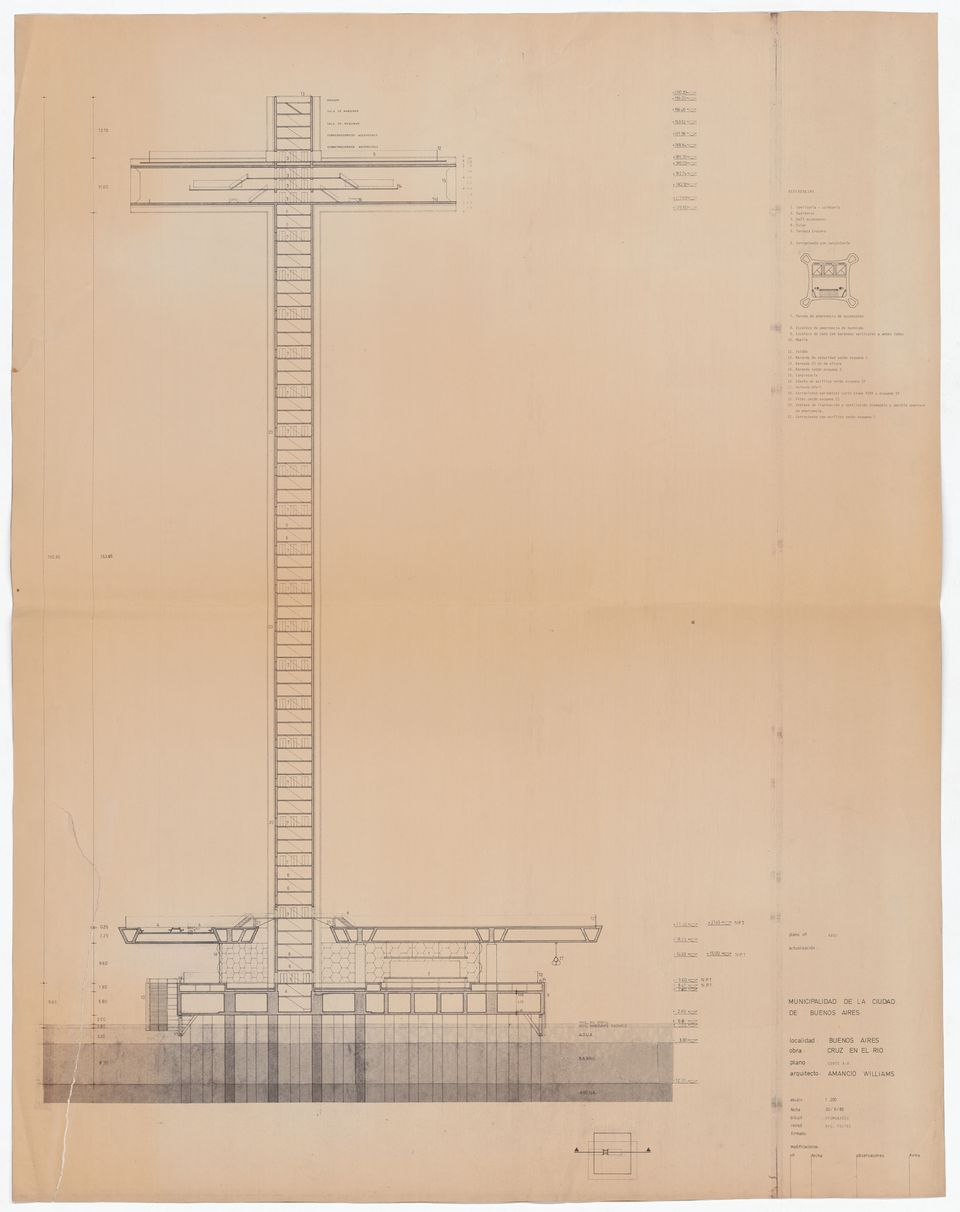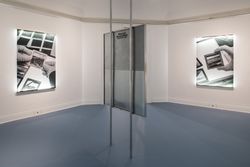On the Horizon
Gilles Delalex and Yves Moreau of Studio Muoto offer a reading of the Amancio Williams archive
This conversation took place during Studio Muoto’s residency at the CCA between 31 October and 5 November 2022. Their reading of the Amancio Williams archive is presented in our Octagonal gallery from 22 June until 17 September 2023.
- GD
- When conducting research in the archives, we tried to concentrate more on Amancio Williams’s documents than on the projects as we knew them—that is, our view was more intuitive in order to react, to be able to discover images and the representation of ideas we were unaware of. When we began our research into Williams’s projects, the one we found the most striking, because it was certainly both a precursor and a manifesto, was the airport project. It’s a very well-documented project. You can tell he put a lot of energy into it. It was an early project in his career, and like many of his projects, it was developed for less than a year but was taken up again later.
- YM
- We noticed that there’s a graphic process in which he redraws his drawings: he starts over, he adds a layer, he reworks it, and all of that over a very long period of time.
- GD
- Yes, these are projects that evolve over time. The airport, in fact, touched on a lot of themes simultaneously. We clearly see in his arguments that this was a very realistic choice, to build an airport on the river, because it’s very shallow. It’s easy to collect water, and this doesn’t stop the city or the airport itself from developing. So it starts from an engineer’s point of view, but there’s obviously a kind of poetry in this ability to land on and take off from a river. He’s an engineer who has a somewhat spiritual view of the landscape and rather clear arguments about wanting to leave the original land as it is, to not disturb the landscape, and to leave it as a kind of magical, divine creation. And that was his argument for why it was interesting to raise the buildings, to keep them off the ground, to build them on pillars, and, for example, to put the airport above the water. Infrastructure is not just something functional for him; it’s a vessel, a tool, a way to “advance” human civilization, to a certain extent.
- YM
- His engineering training was an essential starting point in all of his projects. When he decided to put an airport on pillars, it’s because he realized that the seabed wasn’t suitable or didn’t have the capacity to form an island.
- GD
- What’s interesting is that suddenly, the subject of the drawing becomes structural elements.
- YM
- But there’s also the relationship to the ground and the subsurface. Because in all of his section drawings, whether for the airport project or others, all elements that rise from the ground are still anchored to the ground. So there’s this work of the foundation, of the section, of something that emerges from the ground and rises to the sky.
- GD
- The relationship to the ground was one of our first considerations, more specifically his relationship to the geography, to the land, to the city. We wondered, how did he see things? His background as a pilot made us think that he looked at the world from above, from his plane. This view gave him a fairly distant perspective. And we found a number of photographs that had been taken from a plane. His work definitely intertwines these two gazes, from top to bottom and from bottom to top.
- YM
- And he also had a fascination for certain engineering structures, like bridges. We can create an analogy between his passion, either for aviation or for these structures, and the projects he began to draw as early as 1945, very early in his career.
- GD
- We noticed that his projects were extremely pioneering. For instance, the principles of the airport section are something we see in many of his projects. It’s basically the idea of raising the ground, of recreating an artificial horizon that acts as a new support for what he refers to as humanity. Today, we’d refer to it more as community, but I think that back then it was more about the whole world. The idea of rebuilding the ground to provide new conditions, to look at the future, to project ourselves anew. To see far, to think big. There’s always this sense of distance in his gaze. He had a very specific view on geography, on the notion of the coast, of division, of the limit between the land and the water.
- YM
- The city is in fact part of ground. He makes no distinction between what he calls “la pampa,” what is the city, and the coast. The coast becomes the limit between the land and the sea.
- GD
- The South American context had an impact on Williams’s work. I don’t think his projects could have existed in Europe because they involved increasingly larger areas. The South American landscape is present in all of his projects, and the horizon is an omnipresent element. Whether it’s a factory, a hospital, or an airport, there is always the horizon: the original horizon of the Earth and the new horizon that he created above it. What we have understood from this is that to enter into a dialogue with the existing area, his approach was not to become conflated with it, but rather to detach from it. An alterity must be created. It was this alterity that allowed him to create a dialogue. This position was quite different from what we often see today in terms of ecological thought.
- YM
- And he transcribed this horizontality in his documents—specifically the size of his documents, as we discovered in the archives at the CCA. We’ve unrolled sections and elevations that are three or four metres long. he has a real desire to represent horizontality on a large scale. These were drawings that were worth taking the time to do. He must have felt that they were an extremely important part of his process.
- GD
- In fact, what’s interesting about the experience of being in an airplane, the fact that we see the Earth from above, is that it touches on contemporary environmental issues and questions that we see today: should we touch the ground or should we detach from it? Should we merge with natural elements or should we maintain some distance from them? I think, in some way, he’s asking that question even though we sense that he’d be in favour of maintaining a distance. It’s especially visible in the section of the airport with two pillars and the suspended intermediary floor: it conveys the idea of not touching the ground, of detaching from it, like a ballerina dancing on pointe.
- YM
- The water keeps flowing underneath, boats keep passing, there is no disruption to the maritime flow.
- GD
- What’s interesting is that each time, even in the buildings that followed, architecture is a pathway. It always leads somewhere. When he makes bridge-buildings, we go from one place to another and there is a continuity that’s part of a journey, not of containment. Architecture isn’t about putting things inside of something. It’s made for movement, for going somewhere.
I think that Buenos Aires is perhaps a testing ground, but one that has more universal value for him. We sense that he’s on a mission to bring the modern spirit to South America by way of infrastructure. There’s something quite spiritual about his work in that sense. He starts off with a situation, a technique, and then the project always leads him somewhere else. But technique isn’t the goal, it’s the means.
He talks about noble technique and freedom. Basically, that technique brings freedom. There is another project that’s quite fascinating in this regard: a church in the form of a cross, proposed for the same location as the airport. Visitors enter directly into the cross, which is sufficiently large—it’s 200 metres tall, and it offers incredible views. We found an interesting parallel with the view from an airplane, because you see the church from above in his drawings, as if we were circling it, as if we were in space. It’s a spiritual architecture, but it is also a large-scale infrastructure, a structure that elevates. It’s designed with a major axis like the airport, which is horizontal, but in this case is tilted; suddenly, the axis that links the land to the water now links the water to the sky. It’s a cosmic axis that addresses our relationship with the celestial world and blends two worlds that we long thought were totally separate. In Williams’s mind, modernity and magical thinking coexist.
That brings us back to his point of view as a pilot, an aviator with a particularly distant and elevated view, and the desire to share this viewpoint. He invited everyone to have the same experience he had of seeing the ground from above. - YM
- His fascination with making large documents is incredible. He made a vertical section that is extremely detailed and almost two metres tall which shows the whole technical nature of the project. Even if his projects were never built, he designed them as though they would be.
- GD
- These drawings aren’t at all utopian because they are meant to be built. These are projects that are designed to prolong the present; they are part of his era. In his writing, he regularly talks about the necessity to search for the spirit of his time, to try to grasp it. His projects are very realistic, but they just happen to be immensely ambitious.





Translation from French by Jo-Anne Balcaen.



